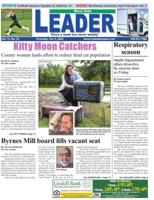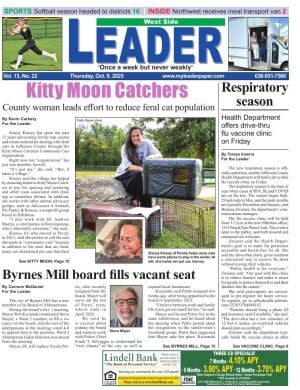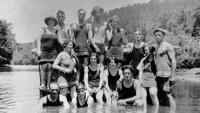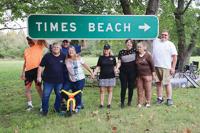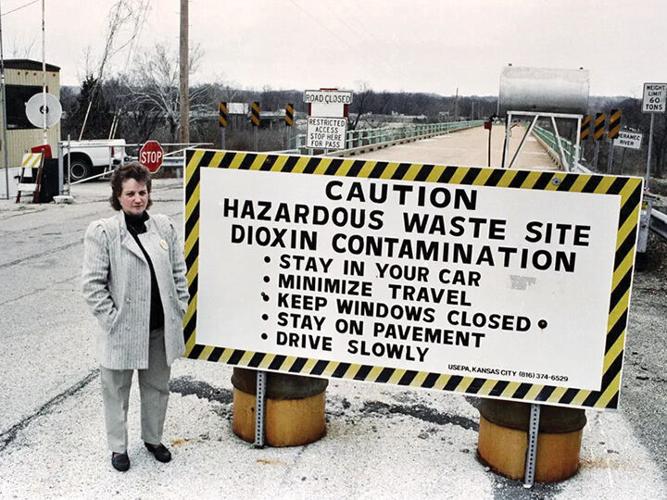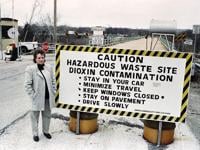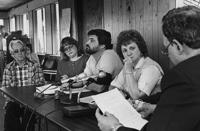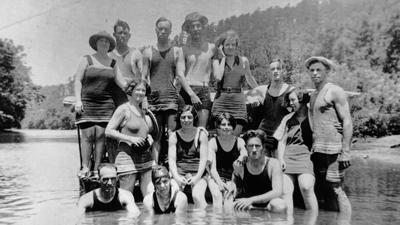Times Beach has changed a lot in the 100 years since it became a city and the 40 years since the Missouri governor called for its disincorporation.
Now considered a ghost town, Times Beach was incorporated in 1925 as a resort town along the Meramec River.
Former resident Frank Purler remembers what life was like in the tight-knit community before the mismanagement of the toxic chemical dioxin forced his family to leave Times Beach in 1983.
Purler, 59, of Dixon lived in Times Beach with his family when he was 3-17 years old.
His family was forced to evacuate their five-bedroom home on Narcissus Street for a mobile home in Gray Summit after the federal government determined the motor oil used to control the dust on Times Beach’s gravel roads was laced with dioxin, posing significant health risks to residents.
The town, home to about 2,000 people at the time, already endured massive flooding in late 1982, causing major damage to the Purler home and many others, before authorities within the Environmental Protection Agency determined permanent evacuation was necessary.
By 1985, all Times Beach residents had fully abandoned their homes, and Governor John Ashcroft issued an executive order for its disincorporation. An incinerator was brought in to burn the town’s dirt, and contaminated homes were buried.
The 400-plus acres encapsulating Times Beach were turned into Route 66 State Park, commemorating the road that runs through it, in 1999.
Purler said there isn’t much evidence left at the park indicating that Times Beach ever existed. He said the water tower with the town’s name was the last structure to go and it is now buried somewhere in the park.
“A lot of people don’t even realize it was a town,” Purler said. “I’m glad it’s a park now (and) it’s not sitting abandoned like it was for so long, but, as you grow up, you always want to go back and visit the place where you grew up. For me, it’s all gone.”

Friends and family gather for the 42nd Times Beach reunion on Sept. 28, 2024, at Route 66 State Park.
Life in Times Beach
Times Beach began to grow after a unique promotion hit newsstands in 1926. The now-defunct St. Louis Star-Times sold a 20-foot-by-100-foot lot in Times Beach for $67.50, advertising the land as a hidden getaway from the hubbub of the city. The purchase included a six-month subscription to the paper.
What originally served as a summer home for many St. Louis-area residents became their permanent home due to various factors like the Great Depression and gas rationing during World War II.
Purler, who has become a historian of Times Beach, collecting old photographs and documents, said the town had many family-owned businesses, like Cashes Tavern, Whiteway Food Market and Steiny’s Inn, where a diner could order a steak dinner for $2.50.
Joe Sonderman, a traffic reporter for iHeartRadio stations in the St. Louis area, said Route 66 was built through Times Beach about seven years after incorporation, when a new bridge over the Meramec River rerouted the historic highway along the southern edge of the town. Sonderman has written 18 books on the history of Route 66, with his latest being “Route 66 St. Louis Style.”
“It wasn’t until 1932 that Route 66 came through Times Beach,” Sonderman said. “It would have been the main road of commerce, taking people to and from it. (Route 66) provided opportunities for people to run gas stations, restaurants and businesses to serve travelers. That became a very important factor in the town’s economy.”
Purler said his family used the Times Beach home as a weekend getaway until he turned 3, when it became their permanent residence. Purler is one of three sons of Frank and Francis Purler. His older brother is Richard, and his younger brother is John. He also has two half siblings, Gary Hicks and Bertha “Pixie” Patterson.
“It was a neat little community,” Purler said. “I remember we often had a big football game between our town and the next one. We’d get together in an empty lot and play against Crescent, for example.”
Purler said the Meramec River, which curved along the northern and eastern portion of the town, played a large role in his youth.
“I used to ride my bicycle down there and use the gas station to air up an inner tube I had wrapped around the handlebars,” he said. “I’d find a piece of Styrofoam or something, put my bike on it, and I’d get on the inner tube, and I’d float from Steiny’s Inn down to the boat dock where the river trestle was. I’d get off and ride home.”
Ghost town
Purler said he remembered the oil-spraying truck coming down his street regularly as a kid. His mother always told him to stay away, so as not to track the oil into her house. Purler said it was common for the neighborhood kids to play outside barefoot, making it nearly impossible to avoid the contaminated gravel roads and soil.
Later, Purler discovered he had a bone tumor on one of his big toes, which needed to be removed. He said his mother and half brother died from cancer, and his half sister also recently died.
To this day, Purler said he isn’t 100 percent sure of the cause of the cancer, but he believes living at Times Beach played a part. He said the EPA’s initial failure to disclose the severity of the dioxin contamination to Times Beach residents led to lots of confusion and anger.
“Back then, it was scary,” he said. “Most people didn’t know anything. I’m telling you, people in chemical suits showed up in people’s front yards, in complete gear, hood and all, and were taking soil samples. People were looking out their windows like, ‘What in the world is going on?’ That’s when everybody really found out. To do that to somebody, still to this day, I don’t get that.”

Former Times Beach Mayor Marilyn Leistner at the entrance to town in 1991.
Sonderman said the Route 66 State Park visitor’s center, 96 North Outer Road, has some information about the town in its museum.
“I feel sad for all those people, but now it’s come full circle and turned into a stopping place, a destination, that people can enjoy safely,” he said. “I think it’s very important that people learn the story and learn about these people. The State Park employees are only too glad to talk about it and tell you the history of what happened.”
Advocacy
After graduating from Pacific High School, Purler joined the U.S. Army, working as a utilities mechanic and truck driver before leaving the military 20 years ago. He continues to work at Fort Leonard Wood as a civilian contractor, instructing driving courses.
Purler helps organize an annual reunion of former Times Beach residents, held on the last Saturday in September at Route 66 State Park. He said the reunion is an opportunity to reminisce and see photograph collections not shown at the Route 66 museum.

The Times Beach Board of Aldermen vote to disincorporate the town in 1985.
Purler recently joined Times Beach’s last mayor, former Eureka Alderwoman Marilyn Leistner, to advocate for victims of chemical contamination in East Palestine, Ohio. The village made international headlines after a train derailment in 2023 caused toxic chemicals on board to spill or catch fire.
Leistner was a Times Beach alderwoman when the city flooded and the dioxin threat was discovered. She became mayor after two resignations. First, Joe Capstick resigned from the mayor’s post. Then, his replacement, Sid Hammer resigned, too. She was elected mayor in June 1983.
Leistner, who lives in Eureka, could not be reached for this article.
Purler called Leistner “an excellent advocate as the ex-mayor of Times Beach.”
“A lot of (Times Beach residents) weren’t treated very well, kind of shunned, with people thinking that we had dioxin contamination,” Purler said. “It’s the fear of the unknown. If that incident happened to anybody you know, with dioxin or otherwise, don’t sit back and say the problem is going to get solved on its own. You have to fight.”
